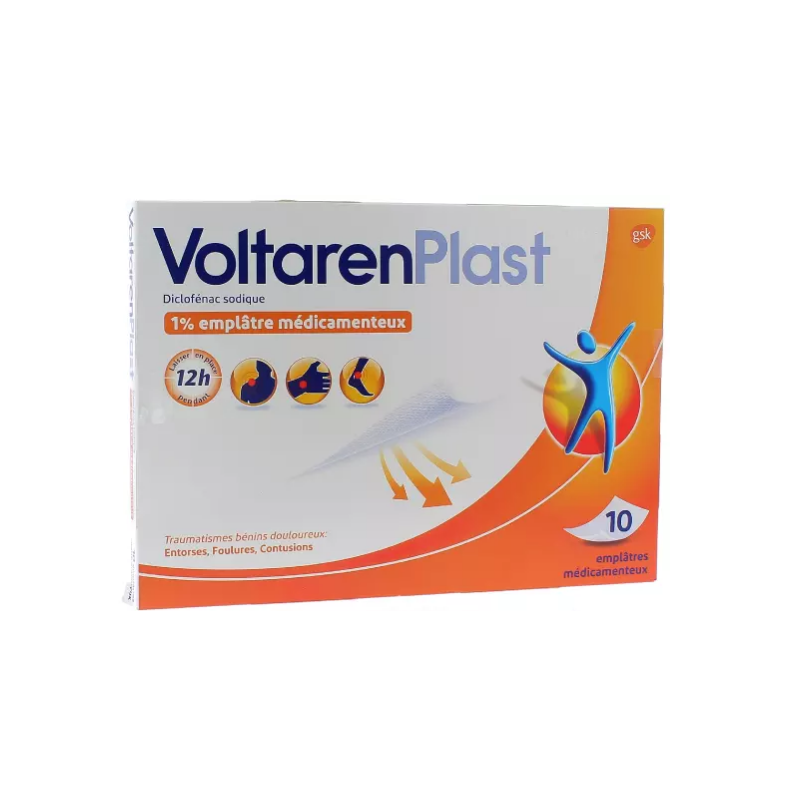Indication
Voltarenplast 1% anti-inflammatory medicated plaster is used for the short-term local treatment of painful minor injuries such as sprains, strains or contusions resulting from sports.
How to take Voltarenplast 1% (see below)
How to use Use only on the skin. Do not ingest! Open the pouch containing the plaster by cutting along the dotted line. 2. Remove one plaster and carefully close the bag by pressing the closure. 3. Remove the protective film from the adhesive surface of the plaster. 4. Then apply the plaster to the painful area. If necessary, hold the plaster in place with an elastic net. Never cover the plaster with an airtight (occlusive) dressing. Never cut the plaster. After using the plaster, fold it in half with the adhesive side facing inwards. Dosage The usual dose is: Adults : Apply one analgesic plaster to the painful area twice a day (morning and evening). The maximum total dose that can be used is two plasters per day, even if there is more than one injury to treat. Do not treat more than one painful area at a time. Children and adolescents: Due to the lack of specific studies, Voltarenplast 1% medicated plaster should not be used in children and adolescents under 15 years of age. Duration of treatment Never use Voltarenplast 1% medicated plaster for more than three days without consulting your doctor. This medicine may only be used for a longer period of time after consultation with your doctor and should not be used for more than 7 days. If you feel that the effect of Voltarenplast 1% medicated plaster is too strong or too weak, consult your doctor or pharmacist.
Composition of the medicine Voltarenplast
Active substance (for one medicated plaster) : Diclofenac sodium (anti-inflammatory): 140 mg Other ingredients: Glycerol, propylene glycol (E1520), di-isopropyl adipate, liquid crystallizable sorbitol (E420), sodium carmellose, sodium polyacrylate, basic copolymer of butyl methacrylate, disodium edetate, anhydrous sodium sulphite (E221), butylated hydroxytoluene (E321), co-dried potassium aluminium sulphate, anhydrous colloidal silica, light kaolin, macrogol lauric ether, levomenthol, tartaric acid, purified water.
Packaging
Voltaren plast 1% medicated plaster is a plaster measuring 10 cm by 14 cm, with a uniform layer of white to light brown paste spread on a non-woven backing and a removable protective film.
Contraindications
Never use Voltarenplast 1% medicated plaster - if you are allergic (hypersensitive) to diclofenac, propylene glycol, butylated hydroxytoluene or any of the other ingredients of VOLTARENPLAST 1% medicated plaster, - if you are allergic (hypersensitive) to other non-steroidal anti-inflammatory drugs (NSAIDs), such as acetylsalicylic acid or ibuprofen - if you have a history of asthma, skin reaction or swelling inside the nose causing irritation following acetylsalicylic acid or other NSAIDs, - if you have an active digestive ulcer, - on skin wounds (e.g. abrasions, cuts, burns), infected skin lesions or eczema, - during the last three months of pregnancy.
Pregnancy and breastfeeding
Voltarenplast 1% medicated plaster should only be used during the first 6 months of pregnancy on the advice of your doctor. Voltarenplast 1% medicated plaster should not be used during the last three months of pregnancy because of the risk of increased serious consequences for mother and child (see section "Never use Voltarenplast 1% medicated plaster"). Diclofenac is excreted in very small amounts in breast milk. As no adverse effects have been observed in infants, it is not generally necessary to discontinue breastfeeding during short-term use. Voltarenplast 1% medicated plaster should never be applied directly to the breast. Ask your doctor or pharmacist for advice before taking any medicine.


 100% secure payment, Customer Satisfaction
100% secure payment, Customer Satisfaction
 Order shipped within 24 hours from Monday to Friday*
Order shipped within 24 hours from Monday to Friday*


